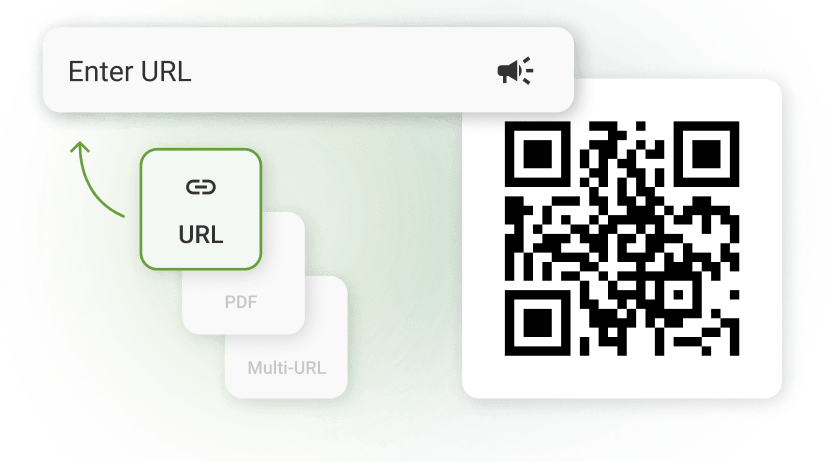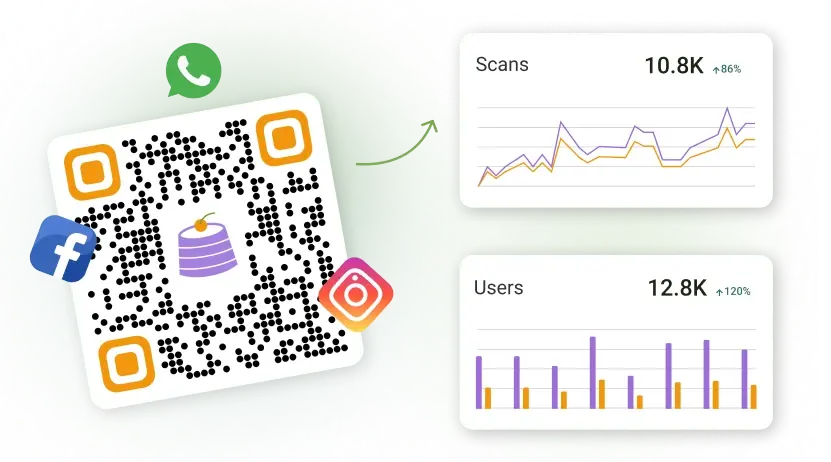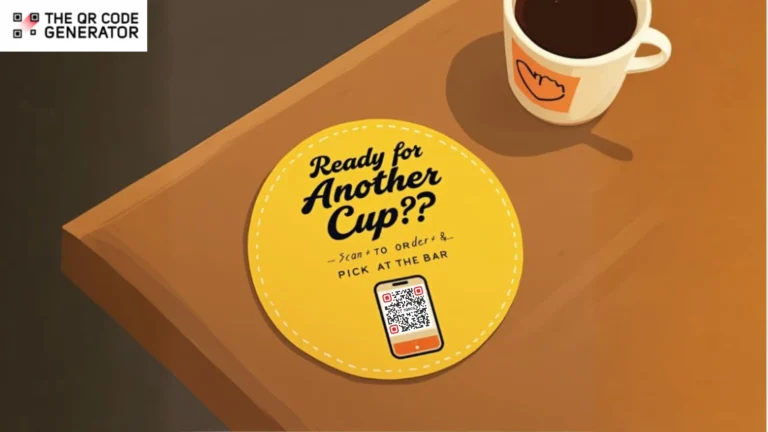Your 8 AM rush just hit. Twenty customers crowd the counter, three baristas scramble, and the espresso machine steams nonstop. Does this sound familiar?
If you run a cafe, this scene is your daily reality. Your staff may try to stay polite while juggling verbal orders, correcting mistakes, and keeping the line moving, but your customers become increasingly impatient. According to QSR Magazine, more than half of diners get impatient in just 10 minutes.
These expectations can feel unmanageable for the staff. The pressure doesn’t just slow service. It affects accuracy, upselling, and even your team’s morale.
Now imagine if customers could place their orders without speaking to the staff. We’re suggesting no shouting, no missed modifiers, and zero holding up the line.
That’s what countertop QR Code displays offer. They shift ordering and menu browsing to the customer’s phone, allowing your team to focus on making drinks and delivering better service.
With a quick scan, customers can browse your whole menu, customize their orders, and send them straight to the counter or kitchen. Plus, it avoids repeated “what was that again?” moments.
The benefits are clear, but they start with understanding why traditional counters create bottlenecks and how QR Codes remove them.
Table of contents
- Why traditional counters slow you down and how QR Codes fix it
- How to use counter QR Codes for peak hour success
- Best practices that separate smart QR Code setups from the average
- A small display that solves your biggest rush hour problems
Why traditional counters slow you down and how QR Codes fix it
When peak hour hits, most cafes don’t fail because of lazy staff or bad coffee. They fail because traditional counter setups weren’t built for today’s speed, complexity, or customer expectations. Here are the most common challenges that overload staff during peak hours:
1. Order backlogs and the “shouting match” effect
During peak hours, verbal orders can pile up faster than your staff can handle. Baristas start yelling drink modifications over the espresso machine just to keep up. This often results in misheard orders, wrong ingredients, and frustrated customers.
Furthermore, the orders requiring remakes due to errors will naturally have a longer total wait time. That’s more than just a minor inconvenience. It’s a lost sale, a longer queue, and a big hit to your cafe’s experience.
If your morning rush sounds like a shouting match, it’s time to offload that chaos to a quieter, more accurate system.
Counter QR Codes can fix order backlogs
Dynamic QR Codes linked to your ordering system let customers place orders directly from their phones. This way, orders come in the proper sequence, and are automatically queued for fulfillment. Plus, built-in analytics from tools such as The QR Code Generator(TQRCG) help you see peak scan times and plan staffing accordingly.
2. Training bottlenecks that stall service
New hires may not instantly know how to ring up an oat milk flat white with sugar-free vanilla and light foam. On average, it takes employees almost three months to learn complex drink builds, upsells, and system workflows.
During that time, the speed of your service slows down. Even worse, senior staff have to stop what they’re doing to correct mistakes. That ends up wearing down your best workers.
Counter QR Codes can solve training problems
A digital QR-based menu helps new staff focus on fulfillment instead of memorizing dozens of variables on day one. That’s a better way to train without risking customer satisfaction. With a QR Code menu, customers build their orders digitally, reducing the burden on new staff to memorize every menu variation. Dynamic editing allows you to instantly update recipes, modifiers, and pricing, eliminating the need for retraining sessions or manual updates.
3. Lost upsell opportunities under pressure
No one wants to upsell when the line is out the door.
Theoretically, your staff should offer that almond croissant or a cold brew add-on. In practice, the average ticket size may drop during peak hours compared to off-peak.
Why? Because baristas prioritize speed over sales when under pressure.
Counter QR Codes can upsell for you
A well-designed QR Code on your counter would take some pressure off your staff and actually let them talk about add-ons and special offers. Plus, the QR Code can prompt every customer with upsell options, regardless of the length of the line. That’s extra revenue without extra effort.
Digital menus linked to your QR Codes can feature upsell prompts, combo suggestions, or “frequently bought together” items whenever a customer orders. You can run QR Code A/B tests with analytics on The QR Code Generator to see which upsells perform best, then update instantly.
4. Menu rigidity sparks customer frustration
Your printed board might look nice, but it limits you in all the wrong ways. Customers expect more information, and they want it fast.
Here’s what static menus can’t handle:
- Real-time inventory updates: When items sell out, staff have to break the news at the counter.
- Allergen and ingredient details: If customers don’t share their dietary needs, mistakes happen and orders are returned. This is something you can easily avoid by linking an allergy card to your cafe’s QR Code.
- Language accessibility: If your menu is only in one language, non-native speakers may leave instead of ordering.
Counter QR Codes help reduce customer frustration
Dynamic QR menus can automatically hide out-of-stock items, display allergen warnings, and switch languages based on the customer’s phone settings. This means you do not need to reprint and there will be no delay in updating menus.
5. Spending labor cost on menu repetition
Ever calculated how much time your staff wastes repeating the same menu explanations?
Let’s say it takes 5 minutes per customer to explain drink options, toppings, or specials. Multiply that by 50 customers during a busy morning, and you’re looking at over 4 hours lost daily, just explaining the menu.
That time could go toward prepping drinks, improving service quality, or handling special orders.
Counter QR Codes remove labor cost
With QR Codes, customers can browse the full menu at their own pace before they speak to a barista, which saves time for everyone involved. QR Codes on counter displays shift menu details and ordering onto the customer’s phone.
Now, let’s look at how forward-thinking cafes are already doing this and what you can learn from them.
How to use counter QR Codes for peak hour success
You’ve seen the chaos QR Codes can solve. But how do you set them up in a way that works during peak hours? Here are a few recommendations:

Step 1: Know your goal before you generate the QR Code
Not all QR Codes do the same job. Before you print anything, ask yourself: What exactly do I want this QR Code to accomplish?
- Want to reduce counter orders and free up staff’s time? Link directly to your digital ordering system.
- Looking for customer feedback without slowing service? Point the QR Code to a quick, mobile-friendly survey.
Being clear here saves you a lot of guessing later. If your goal is everything at once, reconsider. Focus on one use per QR Code. Otherwise, people may not scan it at all.
Step 2: Place the QR Code where people naturally look
This part is more important than it sounds.
You want your QR Code at eye-level, especially where the line forms near the counter. Think of counter dividers, sneeze guards, or right near where the card reader sits. Don’t just stick it on the counter and hope for the best.
Also, use directional arrows to guide the eye. A simple “← Scan Here to Order” works better than you think. Most customers won’t go hunting for a QR Code unless it’s obvious.

Step 3: Write a CTA that would convert
Here’s a fact:
“Scan Menu Here” gets ignored.
“Scan to Order & Skip the Line” gets scanned.
Make the benefit clear. Tell people what they get out of scanning it. If they scan it, they must get speed, convenience, or a reward. Say that up front.
Make that obvious if you’re linking to a loyalty signup or pastry pre-order. Don’t bury the value.
Step 4: Create your QR Code
Now that you’ve planned the purpose, message, and placement, it’s time to generate your QR Code. But don’t just use the first free tool you find online. This step matters more than most cafe owners realize.
Start by choosing a trusted QR Code generator such as The QR Code Generator. Next, make sure your QR Code is dynamic. This is where most people go wrong.
A dynamic QR Code lets you change where the code points without changing the physical QR Code itself. So if you want to:
- Swap out your breakfast specials for lunch items by noon
- Hide sold-out items from the menu
- Replace your ordering page with a holiday pre-order form
- Switch from a menu link to a feedback survey after hours
…you can do all of that instantly. No reprinting. No downtime. No delays.
Choose a QR Code generator that offers:
- Scan analytics so you can track usage
- Branding options to match your cafe’s look
- Fast loading times on all devices
- High-resolution exports for print clarity
You only need to set up all the above once in The QR Code Generator, and then you’ll be able to adjust everything from your dashboard. It’s a small decision that saves you money, time, and hassle in the long run.
Step 5: Test your QR Code
Your business depends on the QR Code during rush hour, so do not compromise on testing it.
You want your QR Code to scan instantly, even in low light or glare. Test it with at least three different phone brands or operating systems and from about two feet away, as that’s how far most customers stand from your counter.
Early mornings are tough. Dim lighting and sleepy hands can lead to missed scans. So make your code large enough (at least 1.5 inches), use high-contrast colors (black on white works best), and avoid reflective materials.
The setup isn’t over once your QR Code is live and linked to the correct destination. Where you place it, how fast it scans, and even how your staff talk about it all shape whether customers use it. This next part covers the real-world tweaks that turn a good QR Code setup into a great one.
Best practices that separate smart QR Code setups from the average
A QR Code on your counter can’t be a magic fix. After all, it’s a tool, and it would only work if you use it correctly. Customers won’t use a QR Code unless it’s fast, visible, and feels like the easier option.
These small details can make or break the whole system if you’re serious about cutting stress during peak hours. Here’s how to make sure your counter QR Code setup delivers:
1. Make it fast to scan: Use high-contrast colors such as black on white, and keep the size at 1.5 inches or larger. Add your logo inside the QR Code to build brand trust, especially for first-time visitors.
2. Connect it to your real-time menu: Sync your digital menu or kitchen updates with your QR Code so sold-out items disappear automatically. This will save your staff from having to explain missing items during a rush.
3. Use hardware that holds up: Consider skipping paper tents. Opt for acrylic stands that won’t slide, warp, or absorb spills. If you need something more flexible, laminate your QR Code signs so they’re easy to wipe clean after every shift.
4. Track what works: Use scan data by hour to see what time slots get the most engagement. This helps you move or duplicate codes to where they’ll impact most.
5. Train your team: Staff should know exactly when and how to direct customers to the QR Code. A quick “You can scan right here to order” saves them time and sets the tone for a smoother experience. Additionally, remind them to offer physical menus for guests who need them.
6. Avoid application downloads: A Reddit user says app downloads are unnecessary. With the feedback like that you should always stick to browser-based menus for broader use and faster access.
A small display that solves your biggest rush hour problems
Cafes that add counter QR Code displays and self-ordering kiosks almost always see faster service and fewer errors. Restaurants using these systems often report 20% higher revenue, thanks to such upselling features. You can serve more people during peak hours without stretching your team thin.
QR Codes on the counter aren’t just about speed. They:
- Reduce repeat questions and minimize errors by letting customers review options at their own pace.
- Let staff focus on preparing drinks and food instead of handling orders.
- Support upselling via smart digital prompts, images, and special offers directly on the menu.
- Allow instant, real-time menu updates, reducing the need for constant reprints and associated costs.
For your team, that means fewer interruptions. For your customers, ordering feels more relaxed. And for your business, it’s a smoother, more efficient workflow, especially when it matters most.
If you’re considering upgrading your counter, The QR Code Generator (TQRCG) makes it simple. You’ll get:
- Dynamic menus you can update in real time
- Scan analytics to see what’s working
- Custom branding that fits your vibe
A well-placed QR Code isn’t just a tech fix; it’s like hiring a new front-of-house teammate.







